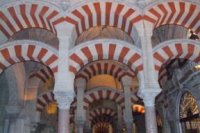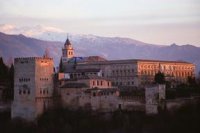Moorish Spain
 Internal divisions within Moorish rule largely explain why the Moors didn’t conquer the whole peninsula in those early days. Had they done so Spain may well have remained a Muslim state until today. Instead an Asturian mountaineer called Pelayo led a band of Christians to the first victory over the Moors at Covadonga in 718. The reconquest had begun.
Internal divisions within Moorish rule largely explain why the Moors didn’t conquer the whole peninsula in those early days. Had they done so Spain may well have remained a Muslim state until today. Instead an Asturian mountaineer called Pelayo led a band of Christians to the first victory over the Moors at Covadonga in 718. The reconquest had begun.
Strangely Moorish Spain wasn’t really ruled by Arabs. It is true that many high positions were taken by Arabs but most of the Moors were Berbers. Later Muwallads (converted Christians) together with the offspring of the first invaders became dominant in Moorish Spain. The invaders brought no women so the second generation of Moors were already half Hispanic!
The first 40 years of Moorish rule was volatile and Al-Andalus needed order and unity which came in the form of Abd-er-Rahman who arrived in Almuñecar on the coast of Granada in 755. Within a year he became Emir of Al-Andalus and during his 32 year reign he would transform this land into an independent state which was the cultural light of Europe.
In Cordoba Abd-er-Rahman I founded the Mezquita in 785 when he purchased the Christian section of the San Vicente Church, a place the two faiths had shared for 50 years. The Mosque was expanded to its final glory over the next two centuries. This became the second most important place of worship in the Muslim world after Mecca.
The Moors expanded and improved Roman irrigation systems to help develop a strong agricultural sector. They introduced many new crops including the orange, lemon, peach, apricot, fig and pomegranate as well as saffron, sugar cane, cotton, silk and rice which remain some of Spain’s main products today.
The frontier in the north between the Moors and the Christians was constantly on a war footing and in St James (Santiago de Compostela), the Christians found their own inspiration to match the Koran-inspired fanaticism of the Moors. Santiago became known as “Matamoros” (the Moor slayer) and to this day is Spain’s patron saint.
However, there was still a long way to go before the Reconquest would succeed. In the mid-10th century Al-Mansur appeared on the scene. He led many expeditions into Christian territory over a period of 20 years and in 997 his army captured Santiago de Compostela. They destroyed the shrine and prisoners took the basilica doors and bells to Cordoba where they would be placed in the Mezquita.
Centuries of painstaking Christian advance had been destroyed by Al-Mansur’s daring raid.
From 1010 to 1195 …
Al Mansur died in 1010 which led to the crisis in which Medina Azahara, the city palace of Abd ar-Rahman III, was destroyed by rampaging Berbers. Moorish Spain deteriorated rapidly into violent turmoil. The caliphate ceased to exist and Al Andaluz broke up into 20 taifas and unified rule came to an end. Seville and Granada were the most powerful of these small kingdoms followed by Cordoba, Almeria, Zaragoza, Badajoz and Toledo. The Moorish warriors were no more as life degenerated into drunken orgies and mercenaries, including Christians, were employed to do the fighting.
 Along the Moorish/Christian frontier castles had been built to protect against Arab attack leading to the area being named Castile. The kingdom of Leon had lead the reconquest until Al-Mansur’s raid on Santiago then Navarra under Sancho III became the key force. Sancho gained control of Castile through marriage and placed his son Fernando on the throne. Fernando then occupied Leon and became emperor of the Spains. Castile would now dominate the reconquest.
Along the Moorish/Christian frontier castles had been built to protect against Arab attack leading to the area being named Castile. The kingdom of Leon had lead the reconquest until Al-Mansur’s raid on Santiago then Navarra under Sancho III became the key force. Sancho gained control of Castile through marriage and placed his son Fernando on the throne. Fernando then occupied Leon and became emperor of the Spains. Castile would now dominate the reconquest.
When Fernando I died after taking lands from Valencia to Portugal, power was split between his sons, Alfonso in Leon and Sancho in Castile. Sancho was served by a young knight who would become known as El Cid Campeador. Sancho was murdered and his brother was suspected so El Cid made Alfonso swear under oath that he had no part in the murder. Alfonso became ruler of a united Castile and Leon and a few years later sent El Cid into exile after a dispute. In 1085 Alfonso’s army recaptured Toledo in the first crucial victory of the Reconquest.
This news didn’t go down well in Muslim north Africa and an army of Almoravids (fanatical Muslim nomads from the Sahara) was invited by the taifa of Seville to reassert the balance of power. They arrived in 1086 and annihilated Alfonso’s army. Fernando again turned to El Cid for assistance. In 1099 El Cid died and for a few years the Almoravids controlled southern Iberia from Marrakesh.
The tolerant society of the caliphate and the taifas disappeared as the Almoravids persecuted Christians and Jews. Another fanatical group, the Almohades, came from the Atlas mountains of Morocco and were natural enemies of the Almoravid desert tribes. They conquered Marrakesh then invaded Al-Andalus to again unite the region under one Muslim regime. These Almohades ordered the destruction of all churches and synagogues forcing Christians and Jews to swarm to the north.
In spite of this fanaticism, a period of great cultural achievement occurred under the Almohades which was the brightest period between the caliphate and the glories of Granada centuries later. The minaret of the Seville mosque, La Giralda, was built during this period with wide ramps all the way up the tower which allowed the sultan to ride his horse to the top.
Source: www.spanish-fiestas.com
Related posts:








